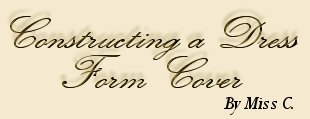



This dress form cover will come in handy for many uses: covering and holding in place padding used on a dress form, covering the gaps in an expandable form while taking photos of completed projects, and to display your newest creation. This cover is made using stretch velvet, although any stretch material could be used for a different look (try white velvet, or maybe a solid, non-textured knit).
Supplies
Dress form
Approximately 1 ¼ yards knit stretch material* (at least 45" wide)
½" wide elastic
Plenty of pins
Thread: contrasting and thread to match your selected fabric
Scissors, needle, ruler
Instructions
1.) Close your dress form up (if its adjustable), leaving between 1/8" and ¼" gap between the sections.
2.) Cut your stretch fabric in half, lengthwise. Pin one piece to the front of the form (along the neckline), being careful to make sure it hangs straight and the pile is going in the right direction. (When you smooth it with your hand going from top to bottom, it should feel smooth, and not like all the fibers are pushing against your hand.) Don't worry if you have a lot of overlap on the sides-you'll use it later.
3.) Repeat step 2 on the back of the form.
4.) Pin the two layers of fabric together along the side of the form (do one side at a time). Make sure you don't stretch the fabric as you do this, but leave it somewhat loose (not so loose that it bags, just enough so that when you expand the form the fabric can expand with it). Start about 4" from the bottom of the form, and continue up the side of the form, taking care to nip in at the waist, up over the shoulder, and stopping right next to the neck.
5.) Repeat on opposite side, taking care to make sure the fabric lays smoothly and is not puckering anywhere.
6.) With needle and contrasting thread, baste the front and back pieces together, along where the pins are (take care not to inadvertently gather the fabric as you go). You may want to take out the pins as you baste, so as not to catch the thread on them. Stop where pins stop at neck.
7.) Continue on other side, but making sure that the fabric isn't puckering as you go. Stop at neck. With the contrasting thread, mark along base of neck along both pieces.
8.) Remove all pins and carefully remove cover from form. Lay cover on a flat surface, such as a large cutting mat or tabletop. With a ruler and pins, mark 5/8" from basting (this will become your seam allowance). True edges as you go (this means smoothing out bumpy curves and wobbly edges). Carefully cut out next to pin line. (Do not cut along the bottom edge-this will be dealt with later.)
9.) Put right sides of fabric together, matching edges as best as possible. Sew up one side, and then up the other. Either zigzag or serge side edges.
10.) To make the neck cover, measure around and the height of the neck on the form. Cut out a strip of fabric as long and wide plus a 5/8" seam allowance on all sides. Using a piece of paper, trace the outline of the top of the neck on the form (which is usually more oval than round) and add a 5/8" seam allowance around the outline.
11.) With the right sides of the neck cover together, sew the two shortest ends together. Pin this "tube" to the torso cover's neck opening. Sew around being sure not to allow the fabric to gather or stretch.
12.) With the right sides of the neck tube and neck top together, sew together again being sure not to allow any gathering. (Basting together before sewing may be helpful to control the fabric.)
13.) Put cover back on form. Measure from end of the form 3"; mark along the bottom of the cover. This will be the casing for the elastic. Cut excess fabric off the bottom of the cover.
14.) Fold under 5/8" along the bottom, and then ½". Stitch fold down along edge creating a casing for the elastic. Leave open 2".Measure the "hem" of the cover, and subtract 2-3" from that measurement (e.g. 38"-3"=35"). Use that measurement (e.g. 35") to cut the appropriate length of elastic. Thread the elastic through the casing being sure the elastic doesn't twist. With the ends of the elastic together, stitch over the end a few times to secure it. Whip-stitch the opening closed..
Your dress form cover is done at this point! Enjoy using it!
*If you have a larger, plus sized form, you may need more to accommodate the larger size. The cover pictured in this article was made for a Dritz "My Double" medium form.
Artwork is October (1877) by James Tissot, courtesy of CGFA.
About
Additions
Articles
FAQ
Feature
Links
Poll
Reviews
Resources
©2003 Across the Ages